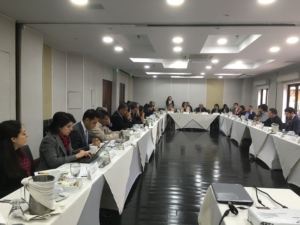Colombia-Venezuela Relations: What Are the Prospects?
Colombia and Venezuela have a history of rocky relations characterized by short bursts of improvement and deterioration.
This post is also available in: Español
Peace in Colombia promises to bring many environmental benefits to the country, but also poses environmental risks associated with the rural development plans contemplated in the post-conflict agenda, according to participants in a special roundtable meeting organized by the Inter-American Dialogue. The one-day meeting, held in Bogotá on August 18, was attended by representatives of environmental organizations, government institutions, such as the post-conflict ministry, the Colombian agency for reintegration, the environment ministry, the national planning department and the agriculture ministry, as well as private sector leaders from the agriculture, oil, infrastructure and mining sectors. The project is funded by the Gordon and Betty Moore Foundation.
Participants at the meeting agreed that the peace accord reached between the Colombian Government and the FARC, which will be put to a referendum vote on October 2nd, brings a great opportunity for Colombia to move toward sustainable rural economic development. However, the development of industries in areas that have been off-limits due to security concerns, the reintegration of many former combatants in rural areas, and the land restitution process which aims to return lands to victims of the conflict, also bring environmental risks, such as increased deforestation and water shortages and ongoing illegal mining.
One of the key challenges to achieving a sustainable post-conflict agenda will be determining how to allocate limited land resources. The government will have to decide how to prioritize competing demands for land resources for land restitution, economic activities, environmentally protected and indigenous areas. The expansion into former conflict zones of industries such as agriculture, cattle ranching, mining and oil exploration, could lead to increased deforestation and water shortages if economic development plans are not carefully crafted. Colombia has large swaths of arable land that could be used for agriculture production but the government will seek to limit expansion to avoid deforestation. The land fund that will be used to allocate lands to victims of the conflict has not yet been established and it is unclear how much land will be needed for this process and whether it will increase deforestation.
Former combatants may also put pressure on land resources. Former guerillas that participate in the reintegration process can choose whether they prefer to relocate to urban areas or remain in rural areas. Historically 80 percent of reintegrated combatants have opted to go to urban areas, in part because the ongoing conflict prevented them from returning to rural areas. But following the peace accord a higher percentage of former combatants may choose to remain in rural areas. There is also a risk that former combatants return to illegal mining activities, which causes severe degradation to the environment.
 The distribution of limited funds for the post-conflict era is another challenge to environmental protection. The Colombian Government has been actively seeking international assistance to implement the peace agreement. However participants noted that these international donations will likely diminish within the next year or so and the government needs to use these resources strategically for maximum benefit. At the national level, Colombia currently faces a fiscal crunch driven primarily by the decline in global oil prices so it must cautiously allocate scarce resources toward implementing the post-conflict agenda, which experts estimate will cost billions of dollars.
The distribution of limited funds for the post-conflict era is another challenge to environmental protection. The Colombian Government has been actively seeking international assistance to implement the peace agreement. However participants noted that these international donations will likely diminish within the next year or so and the government needs to use these resources strategically for maximum benefit. At the national level, Colombia currently faces a fiscal crunch driven primarily by the decline in global oil prices so it must cautiously allocate scarce resources toward implementing the post-conflict agenda, which experts estimate will cost billions of dollars.
Several participants argued that Colombia needs to improve its investment climate for large industries such as agriculture and oil and gas -- industries that can make a substantial contribution to government revenues -- but regulators must ensure that they use environmentally sustainable practices.
Weak institutions pose another major challenge to the post-conflict implementation. Participants noted that while Colombia is a highly centralized government with most revenues and decision-making concentrated in Bogotá, the peace process will have to be implemented in the regions, where governments have fewer funds and less capacity to implement environmental regulations.
Some of the many policy solutions proposed throughout the meeting include the following:
Comments from this meeting will serve as the basis for a forthcoming report with recommendations to mitigate the environmental impacts of the post conflict. See below for the roundtable agenda and list of participants.
Colombia and Venezuela have a history of rocky relations characterized by short bursts of improvement and deterioration.
On August 7, an important chapter in Colombian-Venezuelan relations that has coincided with the presidencies of Alvaro Uribe and Hugo Chavez will come to an end. These last eight years have been a rollercoaster, with moments of great tension but also occasional pragmatism.
After decades of violence, peace remains a coveted yet elusive goal in Colombia.
